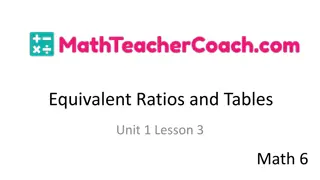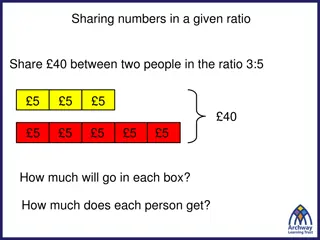Exploring Ratios and Proportions in an Engaging Learning Session
Dive into a dynamic learning experience focused on ratios, proportions, and pattern recognition. Engage in counting activities, memory tests, and visual challenges to strengthen your understanding of mathematical concepts. Uncover the significance of clear instructions and effective strategies in enhancing learning outcomes. Explore the interplay between fractions, divisions, and whole representations in problem-solving scenarios.
Download Presentation

Please find below an Image/Link to download the presentation.
The content on the website is provided AS IS for your information and personal use only. It may not be sold, licensed, or shared on other websites without obtaining consent from the author. Download presentation by click this link. If you encounter any issues during the download, it is possible that the publisher has removed the file from their server.
E N D
Presentation Transcript
Wednesday Morning Ratios to Proportions: An Introduction
Counting Activity On the next slide, count the total number of vowels that you see you will have 30 seconds.
Cat Lives Bowling Pins Football Team Dozen Eggs Unlucky Friday Valentine s Day Quarter Hour Dollar Bill Dice Tricycle Four Leaf Clover Hand Six-Pack Seven-Up Octopus
Words Write down any words you remember from the previous slide
Look for Patterns Cat Lives Bowling Pins Football Team Dozen Eggs Unlucky Friday Valentine s Day Quarter Hour Dollar Bill Dice Tricycle Four Leaf Clover Hand Six-Pack Seven-Up Octopus
Looking Again How many words do you remember this time? Are you smarter than you were the first time you were asked to list words? What changed? You can significantly increase your performance on a learning task if they: 1. Are very clear about what you will be required to do 2. Have a strategy for noticing things so you can link and relate to the information
Chances The chances of finding it are greatly increased if you are asked to look for it !
What Fraction of the Picture is Blue?
Division Problem 3 4 1 2=11 Consider the problem 2 What does the in the answer represent? A) of B) of C) of 1 D) None of these
Ratios and Proportions Perhaps the most important issue to notice when working with ratios and proportions is thinking about what represents the whole
Hummingbird Feeder Nectar for the feeder is to include cup of sugar for every cup of water. What ingredients will I need to make 30 cups of nectar for the feeder?
Hummingbird Feeder I just bought a 12-fluid-ounce hummingbird feeder. If I want to make enough nectar to fill the feeder twice, approximately how much sugar and how much water will I need?
Mixing Paint Jessica gets her favorite shade of purple paint by mixing 2 cups of blue paint with 3 cups of red paint. How many cups of blue and red paint does Jessica need to make 20 cups of her favorite purple paint? Use snap cubes to model this.
Mixing Paint Let s see how an actual Grade 6 class handled this task on the first day of their Ratios Unit: VIDEO
Mixing Paint Questions 1. What misconceptions did the children appear to have? How did the teacher attempt to resolve those misconceptions? What suggestions would you have for changing the lesson and for where she should go next with the lesson? 2. 3.
Mixing Paint Questions 1. How can we use Cuisenaire Rods to model this problem? 2. What other approaches can be used to model and solve this problem?
Mixing Paint Let s look at a download from the Illustrative Mathematics website that poses the problem and six different solution methods
Thursday Morning Ratio, Proportion, and Algebra
A Problem Carol spends 17 hours in a 2-week period practicing her culinary skills. How many hours does she practice in 5 weeks? Come up with as many ways of representing and solving this problem as you can think of and be prepared to share solutions.
Proportions Why does cross multiplication work as a method for solving proportions?
The Ball Bouncing Experiment
The Problem/Task Which ball bounces best a super ball, a golf ball, a tennis ball, or a ping pong ball?
Ball Bouncing Questions What does the slope of the line of best fit represent in real life terms? Which ball bounces the best from a freefall? How do you know? What are the mean, median, mode, and range of the slopes for each ball?
Ball Bouncing Activity Students divided into teams of 3 or 4 Each team given a tennis, ping pong, golf, and super ball and a meter stick Students drop each ball from at least 5 different heights, recording the drop height (x) and the bounce height (y) for each Data are organized into tables Scatter plots are drawn for each ball
Ball Bouncing Group Data
Slope In each case, the slope represents a rate of change a ratio that can be used to determine bounce height for a ball dropped from any height. Bounce heights can be determined by using proportions based on the slope (e.g., how high would we expect the tennis ball to bounce if dropped from 85 cm?).
Wooden Cubes Task In this task, we make a comparison of two different types of wooden cubes by weighing them on a balance.
Wooden Cubes Task How do the slopes of the lines compare? What does this tell us about the two types of wood? Can we write an inequality that compares these slopes?
Ohio Learning Standards Grade 6 6.EE.7 Solve real-world and mathematical problems by writing and solving equations of the form x + p = q and px = q for cases in which p, q, and x are all nonnegative rational numbers. 6.EE.9 Use variables to represent two quantities in a real-world problem that change in relationship to one another; write an equation to express one quantity, thought of as the dependent variable, in terms of the other quantity, thought of as the independent variable. Analyze the relationship between the dependent and independent variables using graphs and tables, and relate these to the equation. For example, in a problem involving motion at constant speed, list and graph ordered pairs of distances and times, and write the equation d = 65t to represent the relationship between distance and time.
Ohio Learning Standards Grade 7 7.EE.3 Solve multi-step real-life and mathematical problems posed with positive and negative rational numbers in any form (whole numbers, fractions, and decimals), using tools strategically. Apply properties of operations to calculate with numbers in any form; convert between forms as appropriate; and assess the reasonableness of answers using mental computation and estimation strategies. For example, if a woman making $25 an hour gets a 10% raise, she will make an additional 1/10 of her salary an hour, or $2.50, for a new salary of $27.50.
Ohio Learning Standards Grade 8 8.F.2 Compare properties of two functions each represented in a different way (algebraically, graphically, numerically in tables, or by verbal descriptions). For example, given a linear function represented by a table of values and a linear function represented by an algebraic expression, determine which function has the greater rate of change. 8.F.4 Construct a function to model a linear relationship between two quantities. Determine the rate of change and initial value of the function from a description of a relationship or from two (x, y) values, including reading these from a table or from a graph. Interpret the rate of change and initial value of a linear function in terms of the situation it models, and in terms of its graph or a table of values.
Message The topics of ratio and proportion are not intended to be taught in a vacuum. There are many opportunities within the study of algebra to address the issues of ratio and proportion and integrate these standards.























